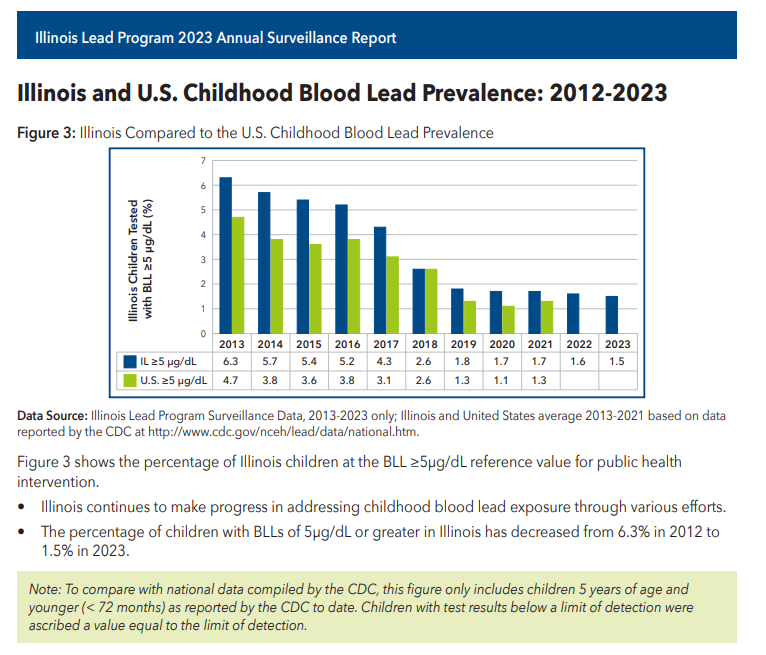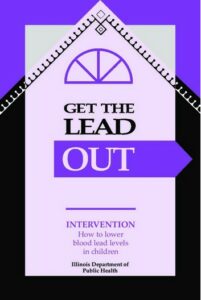What is lead?
Lead is a heavy metal and is one of the Earth’s fundamental substances, naturally occurring in the soil and air. Lead is a hazardous substance. Once lead is removed from ore, it cannot be destroyed. Lead has a long history as one of mankind’s most useful metals. It was used in many materials and products before the risk to children was known. Lead continues to pose health hazards today, even though much is known about the adverse health effects it can cause.
What is lead poisoning?
Lead poisoning is the presence of too much lead in the body, and is the most common preventable pediatric health problem in the United States today. It is caused by exposure to lead that is either eaten or breathed in the form of dust. The body carries the lead in the blood to soft tissues and bones, where it can be stored for many years. Exposure to lead can be harmful to several organs, including the nervous system and kidneys.
What are common items that contain lead?
The largest source of lead is paint manufactured before 1978 and the dust created when it decays. This paint was used for many purposes, including painting the interior and exterior of houses, playground equipment, farm machinery, and toys. Most of the lead used today is used in industrial paint, and the electronics and automobile industry. Other items such as imported toys, cosmetics, jewelry, folk remedies, food, candy, lead crystal, and improperly fired glazed pottery may contain high levels of lead. Certain hobbies — such as stained glass, target shooting and casting fishing weights — can expose people to lead.
Who gets lead poisoning?
People of any age, race, or economic level can get lead poisoning, but children are at the greatest risk. Their small bodies absorb more lead than adult bodies do, and the lead affects them more because their bodies are still growing. Lead often targets the developing brain and nervous system. Children also are more likely to absorb lead dust because they place their hands and other objects in their mouths. Their proximity to the floor place children in greater contact with potentially contaminated dust and dirt.
Even unborn children can be harmed by lead. If a pregnant woman has an elevated blood lead level, the lead can pass from her blood to the blood of her unborn baby, causing damage similar to the problems associated with postnatal lead exposure. Women with elevated lead levels may deliver premature babies
or babies with low birth weight. These children are more likely to have language and intellectual delays later in life.
Adults with certain occupations that expose them to lead can get lead poisoning as well. These jobs include battery manufacturing and recycling, construction work, auto repair and lead smelting. Workers in these occupations can unknowingly carry lead dust home from the workplace and expose their families.
How many children have lead poisoning?
The burden of Illinois childhood lead poisoning remains one of the highest in the nation. Illinois law requires reporting of all blood lead tests to IDPH. CDC estimates that approximately 500,000 children in the United States have blood lead levels at or above the blood lead reference value (BLRV) of 3.5 micrograms per deciliter. (CDC Lead Prevention)
What are the symptoms of lead poisoning?
Lead poisoning has no obvious signs, and most children do not report any abnormal symptoms. Children with lead poisoning might report stomachaches, decreased appetite, hyperactivity, sleeping problems or irritability. Because these symptoms appear to mimic other childhood problems, lead poisoning is sometimes mistaken for a cold or the flu.
What kinds of complications can lead poisoning cause?
Lead poisoning is related to a number of serious health problems. Children with elevated lead levels may suffer from learning disabilities, mental retardation, behavioral problems, lowered intelligence, stunted growth, and hearing impairment. Convulsions, coma, and death can occur at higher lead levels. Some recent studies claim that childhood lead poisoning can contribute to problems later in life, such as academic failure, juvenile delinquency, and high blood pressure.
How can I tell if my child has lead poisoning?
The only way to diagnose lead poisoning is by having a blood test. A doctor or nurse takes blood from a child’s finger or arm. The health care provider sends the blood sample to a laboratory to find out how much lead it contains. A level of 3.5 micrograms per deciliter (mcg/dL) or greater is considered unsafe. All
children 6 months through 6 years of age who are entering day care, preschool, or kindergarten must be assessed for lead poisoning by a health care provider. Children found to be at risk for lead exposure should have a blood lead test. If the child has an elevated lead level, the healthcare provider must make certain the child has follow-up testing. Providers also must provide education on lead poisoning prevention, risk reduction, and nutritional counseling to the parent or caregiver of children age 6 and younger.
How is lead poisoning treated?
Special drugs, called chelators, may be used to treat children with very high blood lead levels. These medications are given under a doctor’s directions or administered in the hospital either through intravenous or intramuscular injections or by mouth. The medicine attaches to the lead and removes it from the body in the urine. If the lead level is very high, more than one treatment session may be necessary to lower the amount of lead in the blood. Even after treatment, some children’s blood lead levels never decrease to less than 10 mcg/dL. Children with elevated blood levels may be placed on special diets and need to be monitored closely to lower their risk of lead-related complications.
How can lead poisoning be prevented?
If you live in a home built before 1978, lead poisoning can be prevented by taking these simple precautions around the house:
- Cleaning up paint chips and peeling paint.
- Washing floors, countertops and window sills weekly with an all-purpose detergent or a detergent specifically formulated to remove lead dust.
- Feeding children a diet high in iron, calcium, and vitamin C.
- Offering children healthy snacks, such as fruit or pretzels, throughout the day so they will not put non-food items into their mouths.
- Using proper safety measures when renovating or remodeling your house, like not using electric sanders or heat guns to remove paint or wallpaper.
- Assuring that children and pregnant women do not enter the work area until renovations are complete and the area has been thoroughly cleaned.
- Washing a child’s hands, mouth, face, and toys often.
These other precautions also can reduce lead exposure:
- Allowing the cold water to run for several minutes in the morning before using it for drinking, cooking, or mixing infant formula in case lead pipe or solder is present.
- Removing shoes when coming indoors so lead dust is not tracked inside.
- Laundering work clothes separately from other clothes.
- Not serving or storing food in pottery made outside the United States.
- Not allowing children to play with and mouth toys from vending machines.
What Efforts are Being Taken to Reduce Lead in Illinois?
Unfortunately, Illinois has higher rates of lead poisoning among its children than any other state in the nation. But thanks to the efforts of local health departments, health care providers, community-based organizations and interested citizens, Illinois is winning the battle against childhood lead
poisoning. Over the past five years, lead poisoning rates in Illinois have been cut by more than 50 percent.
Medical Management Strategies:
- Children 6 months through 6 years of age are required to be assessed for risk of lead exposure or tested before entering day care, preschool, or kindergarten. Blood tests are recommended at ages 12 months and 24 months. The only way to know if a child has lead poisoning is by testing their blood.
- All blood test results are required by law to be submitted to the Illinois Department of Public Health’s Lead Program.
- Blood tests are compiled, evaluated, and disseminated to appropriate individuals and programs offering services for lead poisoned children.
- Children with elevated blood lead levels are identified and followed for treatment.
- Education sessions to prevent poisoning and present treatment options for childhood lead poisoning are conducted by local health department staff for follow-up services. Lead program regional nurse consultants follow up with children whose counties or local health authorities do not offer services for lead poisoning.
- Educational materials are distributed to health care providers, parents, schools/day care facilities, real estate agents and the general public.
Environmental Strategies:
- Prevention of lead poisoning through environmental remediation is a primary objective of the Illinois Department of Public Health.
- Regional and local health department staff inspect dwellings of children who exhibit elevated blood lead levels. Homes with hazardous lead-based paint conditions are required to be mitigated by rendering the lead-based paint safe, removing the paint, or removing the component that is coated with lead-based paint.
- The Department licenses lead paint inspectors, lead risk assessors, lead abatement contractors, lead supervisors, and lead workers.
- The Department approves lead training course providers.
Using proactive strategies to reduce the lead exposure to our children is necessary for a positive outcome of their future.

2023 Lead Program Annual Surveillance Report (Released 2025)
For more information on lead poisoning prevention, please contact the Illinois Department of
Public Health at 217-782-3517, 866-909-3572 or TTY (hearing impaired use only) 800-547-0466;
or call the Marion County Health Department at 618-548-3878 or 618-532-6518.

